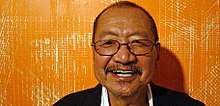Carlos Villa
Carlos Villa (December 11, 1936 – March 23, 2013) was a Filipino-American visual artist, curator and faculty member in the Painting Department at the San Francisco Art Institute.[1][2] His work often explored the meaning of cultural diversity and sought to expand awareness of multicultural issues in the arts.
Carlos Villa | |
|---|---|
 | |
| Born | December 11, 1936 San Francisco, California |
| Died | March 23, 2013 (aged 76) San Francisco, California |
| Nationality | American |
| Education | San Francisco Art Institute Mills College |
| Awards | American Academy in Rome (1987, 2000), Pollock-Krasner Foundation Award (1997) Guggenheim Fellowship (2012) |
Life
Villa was born in San Francisco, California, to immigrant parents in the Tenderloin District. He was introduced to art when taking lessons with his cousin, Leo Valledor,[3] who taught him to study etchings by Matisse. Villa started to display his work in 1958 and went on to receive a B.F.A. in Education in 1961[2] from the San Francisco Art Institute, and a subsequent M.F.A. in Painting in 1963 from Mills College.[4]
Villa died March 23, 2013 in San Francisco from cancer and is survived by his wife, Mary Valledor, daughter Sydney and stepson Rio Valledor.[2]
Career
Villa created multimedia projects and performances that he called "Actions"; these were often group collaborations which dealt with multicultural topics.
In 1976, Villa curated a multidisciplinary, multiethnic exhibition entitled Other Sources: An American Essay, that showcased work by Bay Area artists of color.[5] This exhibition was an alternative celebration of the United States Bicentennial, and focused on people of color and women. It showcased artists including Ruth Asawa, Bernice Bing, Rolando Castellon, Claude Clark, Robert Colescott, Frank Day, Rupert Garcia, Mike Henderson, Oliver Jackson, Frank LaPena, Linda Lomahaftewa, George Longfish, Ralph Maradiaga, José Montoya, Manuel Neri, Mary Lovelace O’Neil, Darryl Sapien, Raymond Saunders, James Suzuki, Horace Washington, Al Wong, René Yañez, Leo Valledor. Live performances by Winston and Mary Tong, Mark Izu and Ray Robles, poetry readings by Janice Mirikitani, Jessica Hagedorn, and Al Robles and numerous others.[5]
In 1995, Villa published Worlds in Collision, a book on multiculturalism in the arts. The contents were transcriptions of presentations and discussions held during the San Francisco Art Institute’s symposia series entitled Sources of a Distinct Majority (1989-1991).[6] The Worlds In Collision project continued in subsequent symposia, web projects and courses until 2013.
In 2010, Villa organized Rehistoricizing Abstract Expressionism in the San Francisco Bay Area, 1950s-1960s, a web project, symposium and exhibition at The Luggage Store Gallery that focused attention on contributions by women and artists of color (primarily abstract expressionist painters) that were overlooked by art history.[2]
In 2011, Villa had a solo retrospective of his work entitled Manongs, Some Doors and a Bouquet of Crates at the Mission Cultural Center for Latino Arts in San Francisco. He was also the subject of the book Carlos Villa and the Integrity of Spaces (Meritage Press, 2011) an anthology of essays about his work and influence edited by scholar Theodore S. Gonzalves, featuring essays and poetry by Bill Berkson, David A.M. Goldberg, Theodore S. Gonzalves, Mark Dean Johnson, Margo Machida, and Moira Roth.[7]
Work
Awards
- Honorable Mention, Richmond Art Center (1959),
- National Endowment for the Arts Grant (1973),
- Adaline Kent Award (1974),
- Guest Artist, American Academy in Rome (1987, 2000),
- Distinguished Alumni Award, San Francisco Art Institute (1989),
- Pollock-Krasner Foundation Award (1997),
- Flintridge Foundation Grant (1998),
- Pamana Award, Filipino American Art Exposition (2000),
- Guggenheim Fellowship, Creative Arts, Fine Arts (2012).[4]
References
- "Faculty Member, Carlos Villa". San Francisco Art Institute (SFAI). Archived from the original on 7 April 2014. Retrieved 5 April 2014.
- "Carlos Villa, artist and teacher, dies". SFGate. San Francisco Chronicle. April 16, 2013. Retrieved November 9, 2014.
- Asian/American/Modern Art: Shifting Currents, 1900-1970. University of California Press. 2008. p. 118. ISBN 9780520258648.
- "Carlos Villa, 2012 - US & Canada Competition, Creative Arts - Fine Arts". John Simon Guggenheim Memorial Foundation. Retrieved November 9, 2014.
- Johnson, Mark (September 11, 2013). "1976 and Its Legacy: Other Sources: An American Essay at San Francisco Art Institute". Art Practical. Retrieved November 9, 2014.
- Villa, Carlos. "Carlos Villa". Guggenheim. Archived from the original on 2014-04-07. Retrieved 2012. Check date values in:
|accessdate=(help) - Carina del Rosario, “Carlos Villa and the Integrity of Spaces” (review) International Examiner, August 1, 2012.